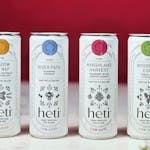Mention fermented beverages from France and your mind likely goes immediately to wine. But in parts of France, the climate is too cool to grow wine grapes. Moving north through the country, you cross from the "grape belt" into the "grain belt" — that part of Europe where beer becomes the drink of choice.
But the cooler climate is also great for growing apples. In the French provinces of Brittany and Normandy, it is hard apple cider that reigns supreme.
The Twin Cities area has seen a recent influx of delicious ciders from these regions.
The ciders of northern France stand out for color, clarity and sweetness. Poured into a Bordeaux wine glass, their deep golden-amber hue, brilliant clarity and sparkling effervescence offer an alluring invitation to drink.
The nose and palate weave a rich tapestry of fruity sweetness that resembles cooked and concentrated red apples. But these are not the one-dimensional, soda-pop-sweet commercial ciders Americans are used to drinking. There is sweetness to be sure, but it's backed up by complex layers of tannin and acid from the multiple varieties of bitter and sour cider apples that contribute to the juice. It's not uncommon to find subtle notes of earth and barnyard brought about by natural fermentation.
The key characteristics of color, clarity and sweetness are part of the cidermaking process called "keeving." This is when the apples are milled and then sit for 24 hours, allowing oxidation to darken the pulp — think sliced apples turning brown when exposed to the air — and haze-forming pectin to leach from the cells.
The pulp is then pressed and the juice is held at a low temperature, halting the immediate start of fermentation. Natural enzymes cause the pectin to coagulate and float to the top. The clear, amber juice is run off and allowed to ferment naturally.
Because keeving also removes important yeast nutrients, fermentation proceeds very slowly, resulting in greater flavor development and the ability to package cider with a relatively high sugar content without pasteurization.
Locally, Cidre Le Brun Bigoud from Brittany has two ciders in the market — the U.S. Department of Agriculture-certified Organic (green label) and Brut (orange label).
Organic hits the tongue with a juicy apple sweetness containing notes of honey, melon and kiwi. The sweetness is cut somewhat in the finish by low tannin and citrus-like acidity. In between are subtle touches of wood, herbs and minerals.
Le Brun Brut finishes drier but has that same overripe fruit sweetness upfront. It gives way quickly to lemony acidity accompanied by hints of pear and earth. It's a bright, refreshing treat.
Twenty cider apple varieties go into the blend that makes the ciders of Cidre de Rhuys, also from Brittany. De Rhuys Doux is a luscious dessert cider — sweet, rich and all about the fruit. The characteristic cooked apple flavor is joined by raisins, herbs and a gentle impression of cinnamon and spice. At only 3 percent alcohol, you can safely savor an entire bottle on your own.
De Rhuys Brut has a similar flavor profile; the cooked apple, herbs and spice all make a return. But the levels of tannin and acid are significantly increased and a longer fermentation period allows the yeast to diminish a greater amount of residual sugar. The result is a good middle-ground cider, sweet enough that it won't put off drinkers of industrial cider, but dry and complex enough for others. .
Like French wine, French cider is an agricultural product subject to annual variations in the crop. Unpasteurized cider is a living product that continues to develop in the bottle.
Several vintages of Cidre Bouché Brut De Normandie from cidermaker Etienne Dupont are available to those willing to seek them out. The search is worth the effort. I tasted the 2013, 2014 and 2015 vintages. Each is good in its own right, but the real treat is seeing how the cider changes over time.
The least interesting of the three is from 2015. It's a brooding, contemplative cider — full-bodied and emphasizing sweetness. A whiff of sulfur in the nose dissipates quickly, leaving behind aromas of red apple, herbs and a touch of barnyard. Baked red apple and brown sugar drive the flavor, with very low lemony acidity offering a slight lift.
Acidity is higher in the 2014 vintage, hitting the tip of the tongue on the very first sip. The baked apple sweetness is still there, but joined by tart, crisp green apple notes and peppery spice. Lively effervescence further cuts the sugar. This one strikes a beautiful balance of sweet and acid with subtle barnyard notes adding depth.
The 2013 vintage is the most interesting of the three. The bruised/cooked apple concentrate flavor is significantly lessened, replaced by bright acidity and tongue-grabbing tannin. Barnyard rusticity is higher, but still remains a background note. Supporting touches of honey and lemon carry through into the dry finish.
Panache is a Minneapolis-based company that in addition to importing cider from Normandy also sells a line of imported apple compotes and infused apple juices made with Minnesota-grown fruit. Panache's ultimate goal is to work with its French cidermaker to produce the cider in-state, as well. But that awaits the better availability of homegrown heirloom apple varieties.
Panache Brut brings the sweetness of Normandy, but with higher attenuation, more acid and more tannin to cut and lift. Subtle notes of pear, lemon and peppery spice swirl around the palate and carry through into the finish. That characteristic rustic barnyard also makes an appearance.
Fruité is Panache's sweetest offering and perhaps the sweetest of all the ciders recommended here. Rich cooked apple leads with significant brown sugar sweetness. Flashes of honey and golden raisins amplify the dessert-like profile. It goes out semisweet with a trace of minerality that brings some drying bitterness to the finish.
Michael Agnew is a certified cicerone, Reach at michael@aperfectpint.net.






